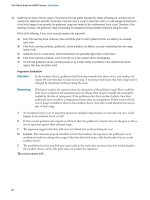INTERNATIONAL ARBITRATION REVIEW TENTH EDITION EDITOR JAMES H CARTER L AWR EVIEWS 2019 LAW BUSINESS RESEARCH LTD
Bạn đang xem bản rút gọn của tài liệu. Xem và tải ngay bản đầy đủ của tài liệu tại đây (398.05 KB, 25 trang )
<span class="text_page_counter">Trang 2</span><div class="page_container" data-page="2">
<small>Reproduced with permission from Law Business Research LtdThis article was first published in August 2019 </small>
<small>For further information please contact </small>
</div><span class="text_page_counter">Trang 3</span><div class="page_container" data-page="3"><small>SENIOR ACCOUNT MANAGERS Pere Aspinall, Jack BagnallACCOUNT MANAGERS Olivia Budd, Katie Hodgetts, Reece WhelanPRODUCT MARKETING EXECUTIVE </small>
<small>Published in the United Kingdom by Law Business Research Ltd, London87 Lancaster Road, London, W11 1QQ, UK</small>
<small>© 2019 Law Business Research Ltdwww.TheLawReviews.co.uk </small>
<small>No photocopying: copyright licences do not apply. </small>
<small>The information provided in this publication is general and may not apply in a specific situation, nor does it necessarily represent the views of authors’ firms or their clients. Legal advice should always be sought before taking any legal action based on the information provided. The publishers accept no responsibility for any acts or omissions contained herein. Although the information provided </small>
<small>was accurate as at June 2019, be advised that this is a developing area. </small>
<small>Enquiries concerning reproduction should be sent to Law Business Research, at the address above. Enquiries concerning editorial content should be directed </small>
<small>to the Publisher – 978-1-83862-037-0</small>
<small>Printed in Great Britain by Encompass Print Solutions, Derbyshire </small>
<small>Tel: 0844 2480 112</small>
</div><span class="text_page_counter">Trang 4</span><div class="page_container" data-page="4"><small>ADVOKATFIRMAET SELMER ASALI BUDIARDJO, NUGROHO, REKSODIPUTRO</small>
<small>ALLEN & GLEDHILLALLEN & OVERY LLPANJARWALLA & KHANNACRA INTERNATIONAL (UK) LIMITEDCREEL, GARCÍA-CUÉLLAR, AIZA Y ENRÍQUEZ, SC</small>
<small>DE BERTI JACCHIA FRANCHINI FORLANIDENTONS</small>
<small>DESIERTO AND DESIERTODR COLIN ONG LEGAL SERVICES</small>
<small>ERDEM & ERDEM LAW OFFICEHANNES SNELLMAN ATTORNEYS LTD</small>
<small>HERBERT SMITH FREEHILLSIPRIME LEGAL LTD</small>
The publisher acknowledges and thanks the following for their assistance throughout the preparation of this book:
</div><span class="text_page_counter">Trang 5</span><div class="page_container" data-page="5"><small>JINGTIAN & GONGCHENGKIM & CHANGLINKLATERS LLP</small>
<small>MARKIDES, MARKIDES & CO LLCMARXER & PARTNER RECHTSANWÄLTEMULLA & MULLA & CRAIGIE BLUNT & CAROE</small>
<small>PINHEIRO NETO ADVOGADOS</small>
<small>PROF. HILMAR RAESCHKE-KESSLER, LLM, RECHTSANWALT BEIM BUNDESGERICHTSHOF</small>
<small>QUEVEDO & PONCERAHMAT LIM & PARTNERS</small>
<small>SOFUNDE, OSAKWE, OGUNDIPE & BELGORE</small>
<small>SRS ADVOGADOS, SOCIEDADE REBELO DE SOUSA & ADVOGADOS ASSOCIADOS, SP, RL</small>
<small>VASIL KISIL & PARTNERS</small>
<small>WEERAWONG, CHINNAVAT & PARTNERS LTDWILMER CUTLER PICKERING HALE AND DORR LLP</small>
<small>WOLF THEISSYKVN</small>
</div><span class="text_page_counter">Trang 6</span><div class="page_container" data-page="6"><small>PREFACE ... vii</small>
<i><small>James H Carter</small></i>
<small>Chapter 1 AFRICA OVERVIEW ...1</small>
<i><small>Jean-Christophe Honlet, Liz Tout, James Langley and Marie-Hélène Ludwig</small></i>
<small>Chapter 2 ASEAN OVERVIEW ...14</small>
<small>Chapter 5 FINANCIAL DEBT AND DAMAGES IN INVESTOR–STATE ARBITRATION ...60</small>
<i><small>Richard Caldwell and Rachael Barza</small></i>
</div><span class="text_page_counter">Trang 7</span><div class="page_container" data-page="7"><i><small>Alejandro Ponce Martínez</small></i>
<small>Chapter 16 ENGLAND AND WALES ...161</small>
<i><small>Duncan Speller and Tim Benham-Mirando</small></i>
<small>Chapter 17 EUROPEAN UNION ...179</small>
<i><small>Edward Borovikov, Anna Crevon-Tarassova, Bogdan Evtimov and Jungmin Cho</small></i>
</div><span class="text_page_counter">Trang 9</span><div class="page_container" data-page="9"><small>Chapter 38 SOUTH KOREA ...409</small>
<i><small>Joel E Richardson and Byung-Woo Im</small></i>
<i><small>Oleg Alyoshin and Vasylyna Odnorih</small></i>
<small>Chapter 45 UNITED ARAB EMIRATES ...493</small>
<i><small>Stephen Burke</small></i>
<small>Chapter 46 UNITED STATES ...502</small>
<i><small>James H Carter and Sabrina Lee</small></i>
<small>Chapter 47 VIETNAM ...522</small>
<i><small>K Minh Dang and K Nguyen Do</small></i>
<small>Appendix 1 ABOUT THE AUTHORS ...535Appendix 2 CONTRIBUTORS’ CONTACT DETAILS ...567</small>
</div><span class="text_page_counter">Trang 10</span><div class="page_container" data-page="10">International arbitration is a fast-moving express train, with new awards and court decisions of significance somewhere in the world rushing past every week. Legislatures, too, constantly tinker with or entirely revamp arbitration statutes in one jurisdiction or another.
The international arbitration community has created a number of electronic and other publications that follow these developments regularly, requiring many more hours of reading from lawyers than was the case a few years ago.
Scholarly arbitration literature follows behind, at a more leisurely pace. However, there is a niche to be filled by an analytical review of what has occurred in each of the important arbitration jurisdictions during the past year, capturing recent developments but putting them in the context of the jurisdiction’s legal arbitration structure and selecting the most important matters for comment. This volume, to which leading arbitration practitioners around the world have made valuable contributions, seeks to fill that space.
The arbitration world often debates whether relevant distinctions should be drawn between general international commercial arbitration and international investment arbitration, the procedures and subjects of which are similar but not identical. This volume seeks to provide current information on both of these precincts of international arbitration, treating important investor–state dispute developments in each jurisdiction as a separate but closely related topic.
I thank all of the contributors for their fine work in compiling this volume.
<b>James H Carter</b>
Wilmer Cutler Pickering Hale and Dorr LLP New York
June 2019
</div><span class="text_page_counter">Trang 11</span><div class="page_container" data-page="11"><b>Chapter 47</b>
<i>K Minh Dang and K Nguyen Do</i><small>1</small>
<b>I INTRODUCTION </b>
<b>i Overview of Vietnam’s legal system</b>
Since its independence in 1945, Vietnam has applied a socialist legal system based on the civil law system.<small>2</small> However, there have been major changes in the country in recent years, including a reorganisation and harmonisation of its laws inspired by other civil law jurisdictions such as France and Germany, as well as the recognition of some court precedents as another source of law.<small>3</small> In light of these developments, Vietnam is a peculiar jurisdiction, mixing aspects of socialist law, civil law and common law.
In Vietnam, legislation is still the most important source of law. Laws are passed by the National Assembly and enacted by the President. Courts are subordinate to the National Assembly and must issue rulings based on the laws in effect.
In 2015, as part of its efforts to reorganise existing legislation, the National Assembly passed the Law on the Promulgation of Legal Documents in which all Vietnamese legal documents are classified by their level of validity (the equivalent of the hierarchy of sources in other civil law jurisdictions).<small>4</small> Article 4 of this statute categorises Vietnamese legal documents into 15 levels, with the Constitution at the highest level of validity. The second level is Vietnamese laws. At a lower level are implementing regulations for these laws issued by the government in the form of decrees of the government or decisions of the Prime Minister. Ministries and government agencies with ministerial rank (such as the State Bank of Vietnam, the Supreme People’s Court and the Supreme People’s Procuracy) may then issue circulars or joint circulars to further implement the decrees of the government.
<b>ii Overview of Vietnam’s judicial system</b>
In Vietnam, the judicial system comprises people’s courts (which include military courts) and people’s procuracies.<small>5</small>
<small>1 K Minh Dang is a senior partner and K Nguyen Do is a partner at YKVN. The authors are grateful to Cam Tu Vo Nguyen (associate) and Hoang Tran Thuy Duong (paralegal) for their kind assistance with the drafting of this chapter.</small>
<small>2 A look at Vietnam’s legal system, The Report: Vietnam 2017, Oxford Business Group (2017).</small>
<small>3 Law No. 62/2014/QH13 on Organisation of People’s Courts passed by the National Assembly on 24 November 2014, effective from 1 June 2015 (Law on Organisation of People’s Courts).</small>
<small>4 Law No. 80/2015/QH13 on the Promulgation of Legal Documents passed by the National Assembly on 22 June 2015, effective from 1 July 2016.</small>
<small>5 Articles 102 and 107 of the Constitution of the Socialist Republic of Vietnam passed by the National Assembly on 28 November 2013, effective from 1 January 2014.</small>
</div><span class="text_page_counter">Trang 12</span><div class="page_container" data-page="12">There are four levels of courts, and the highest court is the Supreme People’s Court.<small>6</small> The Supreme People’s Court is organised into a Council of Judges and supporting apparatus. The Council of Judges consists of the Chief Judge (who is appointed by the National Assembly on nomination by the President),<small>7</small> the deputy chief judges (who are appointed by the President on the nomination of the Chief Judge of the Supreme People’s Court)<small>8</small> and other judges of the Supreme People’s Court (who are appointed by the National Assembly on the nomination of the Chief Judge of the Supreme People’s Court).<small>9</small> The Supreme People’s Court is the court of last resort on all matters arising under Vietnamese law. It also recommends bills to the National Assembly and passes resolutions directing lower courts on the uniform enforcement or implementation of the law across the country.<small>10</small> The three other levels of courts are (1) the superior people’s courts (three courts across the country), (2) the provincial level people’s courts (63 in the country) and (3) the district level people’s courts (one for each district).<small>11</small>
Military courts are established at various levels in the Vietnam People’s Army, with the highest one being the Central Military Court.<small>12</small>
The people’s procuracies (also known as the people’s offices of inspection and supervision) serve as the prosecutorial authority in Vietnam. Their role is to supervise and inspect judicial compliance by judicial agencies and officials. There is a people’s procuracy for every people’s court, and the military has its own military procuracies. The highest procuracy is the Supreme People’s Procuracy, headed by the Chief Procurator of the Supreme People’s Procuracy, who is elected by the National Assembly.<small>13</small>
With respect to arbitration, there is no specialist arbitration court in Vietnam. However, the Supreme People’s Court and the Ministry of Justice have recognised in public forums that the enforcement of foreign arbitral awards under the Convention on the Recognition and Enforcement of Foreign Arbitral Awards of 1958 (New York Convention) has been uneven and inconsistent largely because courts located throughout the country do not have the same experience dealing with enforcement issues. Accordingly, there have been active discussions on the need for a specialist court to promote greater uniformity and predictability in enforcing foreign arbitral awards.
<b>iii Vietnam’s Arbitration Law</b>
In Vietnam, arbitrations are mainly governed by the Arbitration Law 2010, which came into force on 1 January 2011.<small>14</small> Prior to the entry into force of the Arbitration Law 2010, arbitrations were governed by the Arbitration Ordinance 2003, which came into force on
<small>6 The website of the Supreme People’s Court (in Vietnamese) is available at www.toaan.gov.vn. </small>
<small>7 Article 26.1 of the Law on Organisation of People’s Courts.</small>
<small>8 Id. at Articles 28.1 and 27.7.</small>
<small>9 Id. at Articles 72 and 27.7.</small>
<small>10 Id. at Articles 21, 22 and 26.</small>
<small>11 Id. at Article 3.</small>
<small>12 Id. at Articles 49 and 50.</small>
<small>13 Articles 7.1, 40 and 62.1 of Law No. 63/2014/QH13 on Organisation of People’s Procuracies passed by the National Assembly on 24 November 2014, effective from 1 June 2015.</small>
<small>14 Law No. 54/2010/QH12 on Commercial Arbitration passed by the National Assembly on 17 June 2010, effective from 1 January 2011 (Arbitration Law 2010).</small>
</div><span class="text_page_counter">Trang 13</span><div class="page_container" data-page="13">1 July 2003.<small>15</small> Although the Arbitration Ordinance 2003 was superseded and replaced by the Arbitration Law 2010, it remains applicable to arbitrations conducted pursuant to arbitration agreements signed between 1 July 2003 and 31 December 2010.<small>16</small>
The Arbitration Law 2010, which is based on the UNCITRAL Model Law and incorporates international arbitration norms, reflects Vietnam’s intention of becoming a pro-arbitration jurisdiction.<small>17</small> For example, Article 10.4 of the Arbitration Ordinance 2003 invalidates an arbitration agreement if the arbitral institution is not specified and there is no additional agreement in this regard. Under the Arbitration Law 2010, such ground for invalidating an arbitration agreement is no longer provided. Rather, such arbitration agreement is considered unclear, and the claimant has the right to select the arbitral institution.<small>18</small>
Unlike arbitration laws in other jurisdictions, Vietnam’s Arbitration Ordinance 2003 and its successor, the Arbitration Law 2010, do not recognise the concept of international arbitration (as opposed to domestic arbitration). Rather, these arbitration statutes distinguish between foreign arbitration and non-foreign arbitration. Foreign arbitration is defined as ‘arbitration under foreign arbitration law as agreed by the parties to resolve the disputes, whether inside or outside of Vietnam.’<small>19</small> Therefore, an arbitration seated inside Vietnam under the rules of a foreign arbitral institution (such as the ICC, SIAC, etc.) is still considered as a foreign arbitration. As more fully discussed in the next section, the law regarding the recognition and enforcement of an award is different depending on whether the award is issued in a foreign or non-foreign arbitration.
Another significant distinction is a dispute with a foreign element and a dispute without a foreign element.<small>20</small> A dispute with a foreign element means that the dispute involves:
<i><small>a </small></i> at least one foreign individual or foreign legal entity;
<i><small>b </small></i> parties that are all Vietnamese, but where the establishment, modification, implementation or termination of their relationship occurred in a foreign country; or
<i><small>c </small></i> parties that are all Vietnamese, but where the subject matter of their relationship is located in a foreign country.<small>21</small>
<i>A contrario, a dispute without a foreign element does not involve any of the above. The </i>
presence of a foreign element in a dispute does not necessarily define whether an arbitration is foreign. Rather, as discussed below, the distinction is significant to determine, for example, the applicable substantive law or language of the arbitration.
<small>15 Ordinance on Commercial Arbitration No. 08/2003/PL-UBTVQH11 passed by the Standing Committee of the National Assembly on 25 February 2003, effective from 1 July 2003 (Arbitration Ordinance 2003).</small>
<small>16 Prior to the issuance of the Arbitration Ordinance 2003, arbitrations were governed by Decision No. 204-TTg on organisation of VIAC issued by the Prime Minister on 28 April 1993, Decision No. 114-TTg on expanding VIAC’s scope of jurisdiction to settle disputes issued by the Prime Minister on 16 February 1996 and Decree No. 116-CP on organisation and operation of economic arbitration issued by the Government on 5 September 1994.</small>
<small>17 </small> <i><small>K. Minh Dang and K Nguyen Do, GAR Know-How Commercial Arbitration 2019 – Vietnam (2019). </small></i>
<small>18 </small> <i><small>Do Van Dai, Pháp luật trọng tài thương mại tại Việt Nam - Bản án và bình luận bản án (Law on </small></i>
<i><small>Commercial Arbitration in Vietnam – Cases and Review) (in Vietnamese), 115–117, Volume 1 (2018).</small></i>
<small>19 Article 3.11 of the Arbitration Law 2010.</small>
<small>20 See id. at Article 3.4. See also Article 2.4 of the Arbitration Ordinance 2003. </small>
<small>21 Article 663.2 of Civil Code No. 91/2015/QH13 passed by the National Assembly on 24 November 2015, effective from 1 January 2017 (Civil Code 2015).</small>
</div><span class="text_page_counter">Trang 14</span><div class="page_container" data-page="14">If a dispute does not involve a foreign element, the applicable substantive law shall be Vietnamese law.<small>22</small> If the applicable substantive law is not agreed upon by the parties and the dispute involves a foreign element, the applicable substantive law shall be the law the arbitral tribunal deems most appropriate.<small>23</small> If the dispute does not have a foreign element, the applicable language shall always be Vietnamese regardless of the parties’ agreement, except in a dispute where at least one party is an enterprise with foreign invested capital.<small>24</small> If the dispute has a foreign element, or has at least one party that is an enterprise with foreign invested capital, the applicable language shall be the language agreed upon by the parties, and in the absence of such an agreement, the applicable language shall be determined by the arbitral tribunal.<small>25</small>
The Arbitration Law 2010 is supplemented by:
<i><small>a </small></i> Decree No. 63/2011/ND-CP, which includes implementing regulations on the Arbitration Law 2010;<small>26</small>
<i><small>b </small></i> Resolution No. 01/2014/NQ-HDTP, which guides the implementation of certain provisions of the Arbitration Law 2010;<small>27</small> and
<i><small>c </small></i> Decree No. 124/2018/ND-CP, which amends and supplements certain provisions of Decree No. 63/2011/ND-CP.<small>28</small>
Notably, Resolution No. 01/2014 clarifies the provisions on the validity of arbitration agreements; the grounds for setting aside arbitral awards; and the supervisory and supporting role of Vietnamese courts, and their power over foreign arbitrations seated in Vietnam.
<b>iv Recognition and enforcement of arbitral awards in Vietnam</b>
In Vietnam, the procedure relating to the recognition and enforcement of arbitral awards varies depending on whether the award is foreign or non-foreign.
With respect to the recognition of arbitral awards, non-foreign arbitral awards are automatically recognised and are, therefore, effective from their date of issuance.<small>29</small>
On the other hand, foreign arbitral awards must be formally recognised and held enforceable by the competent provincial people’s court.<small>30</small> In 1995, Vietnam became party to the New York Convention. The New York Convention was adopted into Vietnamese law through the Civil Procedure Code (the Civil Procedure Code 2004,<small>31</small> as amended by the
<small>22 Article 14.1 of the Arbitration Law 2010.</small>
<small>23 Id. at Article 14.2.</small>
<small>24 Id. at Article 10.</small>
<small>25 Ibid.</small>
<small>26 Decree No. 63/2011/ND-CP detailing and guiding a number of articles of the Law on Commercial Arbitration issued by the Government on 28 July 2011, effective from 20 September 2011.</small>
<small>27 Resolution No. 01/2014/NQ-HDTP providing guidelines for a number of provisions of the Law on Commercial Arbitration issued by the Council of Judges of the Supreme People’s Court on 20 March 2014, effective from 2 July 2014 (Resolution No. 01/2014).</small>
<small>28 Decree No. 124/2018/ND-CP amending and supplementing a number of articles of Decree No. 63/2011/ND-CP issued by the Government on 19 September 2018, effective from 19 September 2018.</small>
<small>29 Article 61.5 of the Arbitration Law 2010.</small>
<small>30 Article 427.2 of the Civil Procedure Code No. 92/2015/QH13 passed by the National Assembly on 25 November 2015, effective from 1 July 2016 (Civil Procedure Code 2015).</small>
<small>31 Civil Procedure Code No. 24/2004/QH11 passed by the National Assembly on 15 June 2004 (Civil Procedure Code 2004).</small>
</div>








